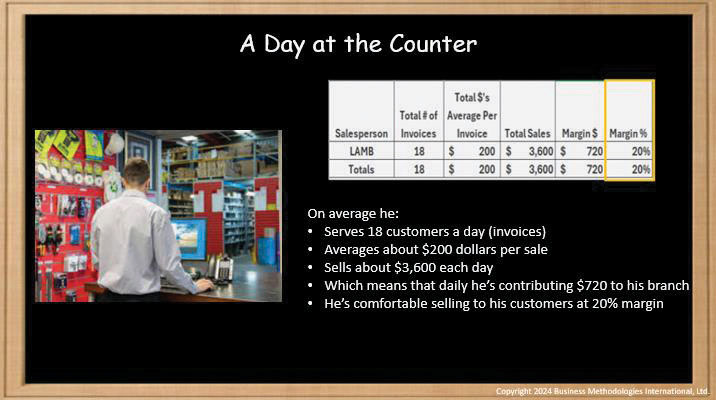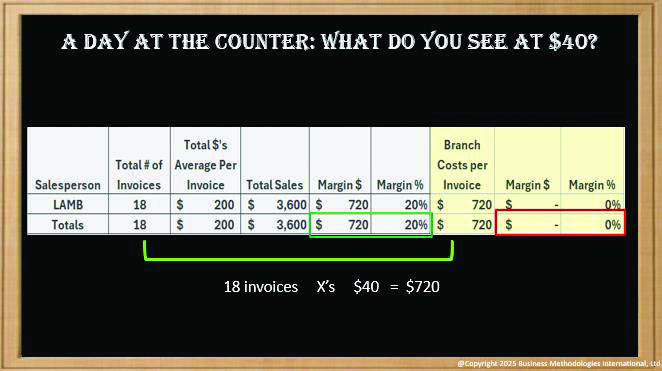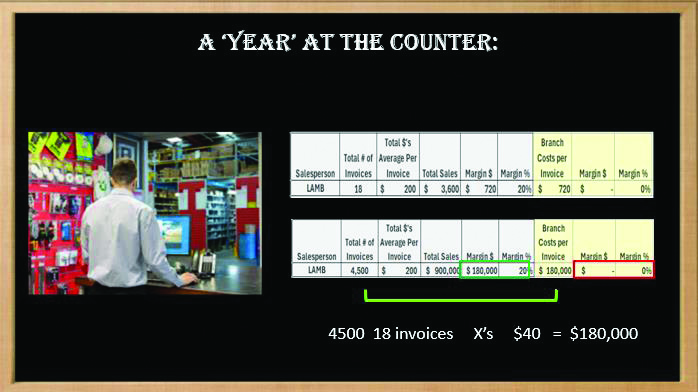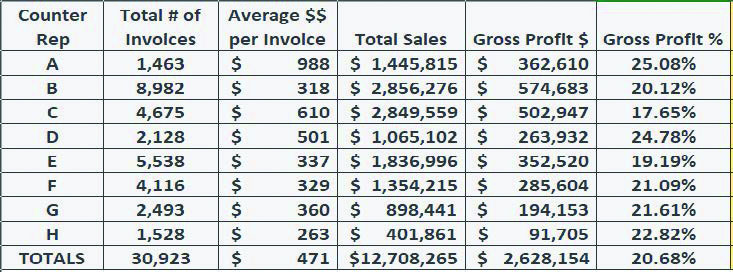WHY THIS MATTERS
In our webcast series, we’ll keep unpacking this idea—tackling real-world examples and sharing tips for:
- Identifying profit opportunities in everyday transactions
- Communicating value, not just price
- Understanding when a discount helps…and when it hurts
- Making each counter interaction count
You’ll also hear directly from counter reps who’ve made small changes that made a big impact—for their branches, their customers and their careers.
Let’s keep the conversation going….
“Because when counter teams understand how they drive profit—not just revenue—they become even more empowered, more trusted and more valuable.”
We all know our businesses come with big expenses—some fixed, some variable. Some of these costs are obvious, like payroll, trucks and product costs. These are the ones you see every day. They’re the activities taking place above the waterline— the visible part of your operations iceberg. But what about the costs below the waterline?
Those hidden, less visible expenses are just as real—and they add up. Most folks don’t see them, think about them or even know they exist. But once you do, it can totally change how you see your impact on the bottom line.
Let’s walk through an example...
So, let’s meet Mr. Lamb

Mr. Lamb is a solid counter salesperson. Here is his typical day:
Sees 18 customers
Averages $200 per invoice
Brings in $3,600 in daily sales
At a 20% margin, that’s $720 in daily margin
Not bad, right? But here’s where things get eye-opening…
Let’s assume that the cost to process just one counter invoice is $40. That includes labor, time, systems, mistakes, returns, you name it.
That means Mr. Lamb’s 18 invoices cost $720 to process.

He’s breaking even. Not losing money—yet—but also not making any. And here’s the kicker: most counter folks have no idea this is happening. We’ve collected data over four years, and more than 60% of counter people are in the same boat—working hard but unintentionally breaking even or even losing money for the company.
When we show this to teams, it’s a game-changer. It helps them instantly understand why you’re always nudging them to go from 20% margin to 20.2% or even 21%. Every fraction of a margin bump matters.
Let’s compare a “day in the life” of Lamb to a “year in the life” of Lamb:

Keeping all things equal, we took the number of invoices (18) and multiplied it by 250 workdays. Here’s what we found.
- Lamb sold $900,000 in sales
- Made $180,000 in margin
- Did not make a profit
It’s crazy to think about. It happens all the time. Let’s look at a real-life example:
A REAL COUNTER SALES TEAM STORY
We worked with a distributor conducting between $50 million and $70 million in sales annually. They had 16 counter salespeople. When we dug into the numbers and worked with their CFO, we found that their cost to process a counter invoice was $70. These were the initial numbers they gave us.

The leadership team was pleased with their counter folks’ efforts. Just these eight reps alone sold more than $12 million. They made a good margin and sold almost 21 cents on a dollar. When we saw the numbers, we acknowledged the above but asked them how much their reps actually earned. To help us understand why we asked the question, let’s look at salesperson “B.”

- $2.85 million in sales
- $575K in margin
- 8,982 invoices processed
- No one realized it cost $70 to process a counter invoice!
That’s $628,740 in processing costs…meaning they actually lost $54,000.
THE $70 WAKE-UP CALL FOR COUNTER SALES SUCCESS
“Once we understood that it was costing them $70 per invoice, everything changed for them. They became more pricing conscious, and they put more effort into up- and cross-selling. The results have been amazing.”
And let’s be clear—this isn’t to point fingers or shame anyone. Person B is working their tail off. But here’s the thing. They had no idea.
Why? Because:
- The system said they were making money
- Nobody ever fully explained why we keep asking for higher margins
- Most counter folks don’t realize how much up-selling and cross-selling impact earnings
- And they’ve never been shown how activity drives cost
FOR LEADERS: THIS IS A HUGE OPPORTUNITY
First: When you analyze your team’s performance with this lens, it opens up a level of insight you may not have had before. Not to punish—to develop.
Second: Rather than get discouraged by red numbers, we can use them to coach. Person B is so close to being profitable. Let’s ask:
- What small changes would help get them there?
- Could margin awareness, bundling or smarter delivery scheduling turn things around?
Third: Pretend Person B was a customer. How many of your customers might be showing green on the surface, but red under the hood? Use this view to ask:
- Are we shipping when available or when complete?
- Are we delivering to the same jobsite multiple times a day?
- Is it time to talk with our customer’s leadership team about a win-win strategy to reduce cost-to-serve?
IT’S NOT ABOUT 20% BEING A MAGIC NUMBER…
Every location does have a line. And if your team is selling below that threshold—or your warehouse ops are inefficient—you’re losing money. Quietly, slowly…but it adds up fast.
You’ve forgotten more about distribution than most of us will ever learn. That’s why this message is shared with respect—and a challenge.
Take a few accounts. Run the numbers. Look at margin after invoice costs. What do you discover?
And when your counter team understands, margin conversations get easier. Decisions get sharper. And the earnings needle starts to move upward.
If you have questions or want to talk through any of this, we’re here. Let’s keep growing—together.